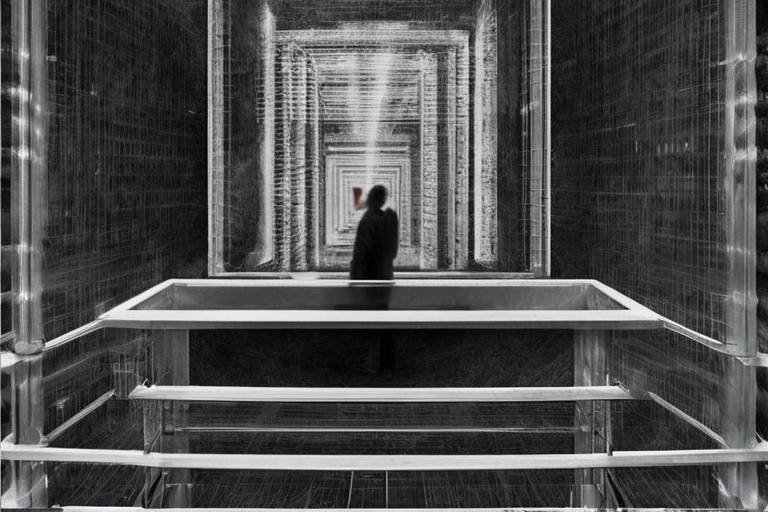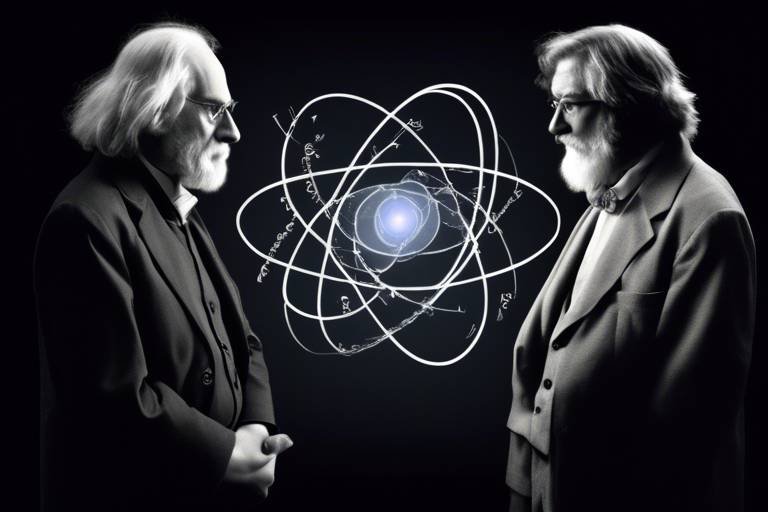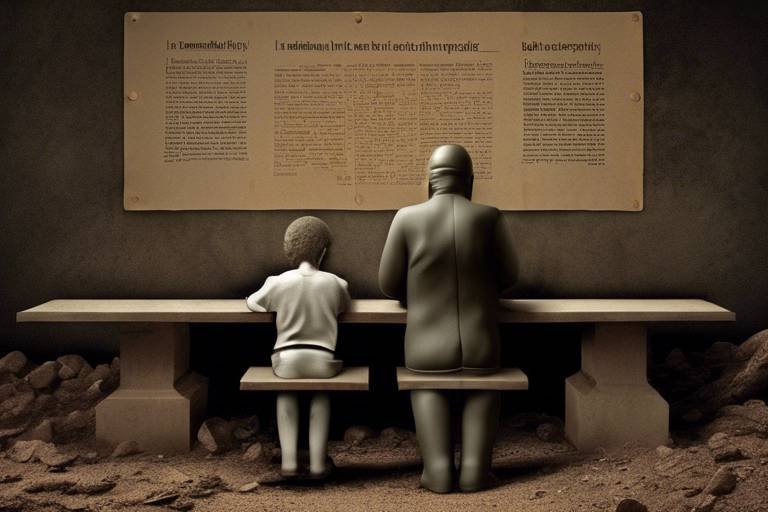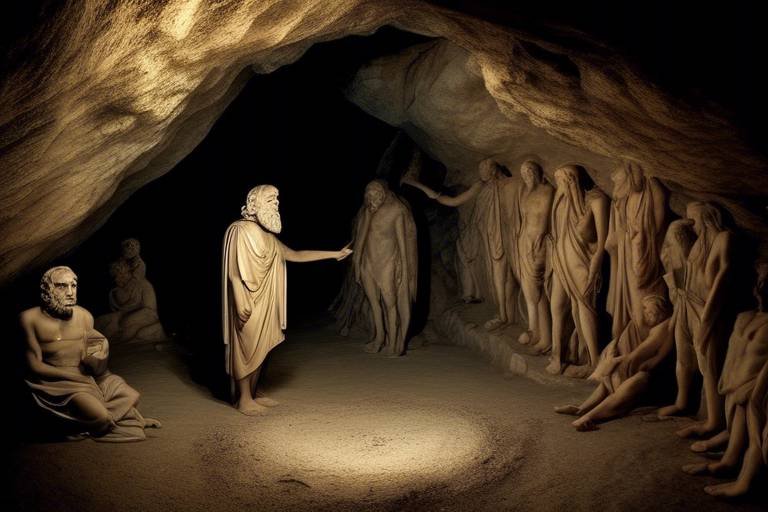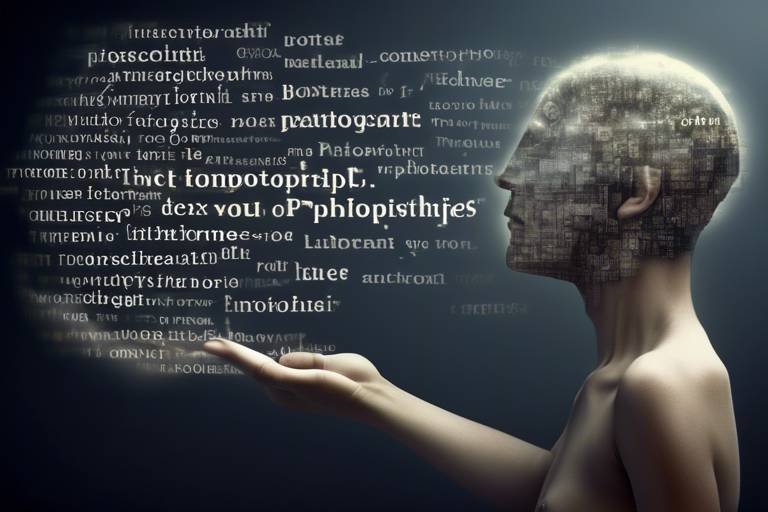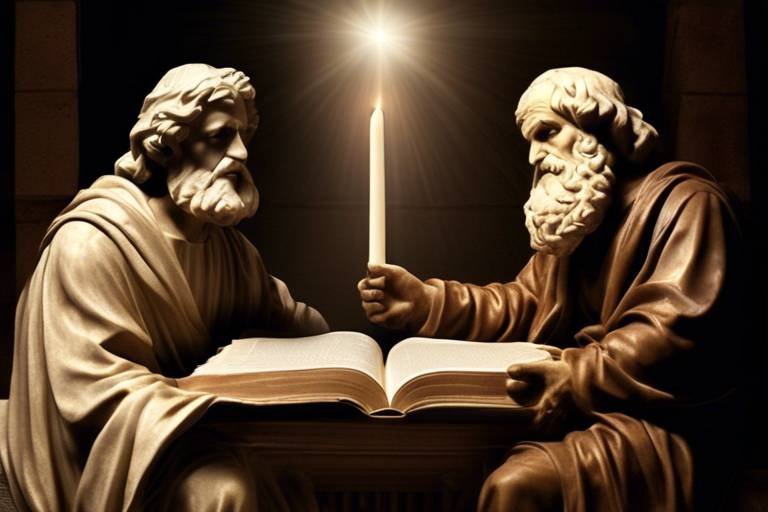Time and Space - A Philosophical Perspective
Welcome to a journey through the fascinating realms of time and space, where we’ll unravel the complex tapestry that defines our existence. Imagine standing at a crossroads, where every moment you experience is intertwined with the vastness of the universe. These two concepts, often taken for granted, are not merely scientific terms; they are profound philosophical inquiries that have puzzled thinkers for centuries. Have you ever pondered whether time is a straight line or a winding circle? Or how space influences our perception of reality? Let’s dive into these questions and explore the intricate relationship between time and space, examining the theories and implications that shape our understanding of existence and reality.
Time is one of those elusive concepts that can feel both familiar and foreign. Philosophers have long debated its nature, with some viewing it as a linear progression from past to present to future, while others argue for a more cyclical understanding. In many cultures, time is perceived differently; for instance, some Indigenous cultures see time as a repeating cycle, emphasizing the importance of seasons and natural rhythms. This perspective invites us to consider how our personal experiences of time might shape our lives. Are we rushing through our days, or are we savoring each moment? The way we perceive time can significantly influence our mental well-being and our connection to the world around us.
Space, like time, is a concept that transcends mere physical dimensions. It's not just the area around us; it's a canvas that holds our experiences, memories, and interactions. Philosophically, space can be understood in various contexts. For example, absolute space, as proposed by Isaac Newton, suggests a fixed framework within which events occur. In contrast, relational space, championed by Gottfried Wilhelm Leibniz, posits that space is defined by the relationships between objects rather than existing independently. This debate raises important questions: Is space merely a backdrop for our lives, or does it actively shape our reality? The implications of these theories extend into our daily lives, influencing how we navigate our environments and perceive our place within the universe.
The clash between absolute and relational space is akin to a philosophical tug-of-war. On one side, we have Newton's absolute space, which acts as a stage for the drama of existence, unchanging and eternal. On the other, Leibniz's relational space suggests that our understanding of space is fluid, shaped by our interactions and experiences. This dichotomy invites us to reflect on our own lives: do we see ourselves as passive participants in a vast, unyielding universe, or as active creators of our spatial reality? The answer may not be straightforward, but it certainly enriches our understanding of existence.
Perception plays a crucial role in how we understand space. Our senses—sight, sound, touch—are the gateways through which we experience the world. Consider how a crowded room feels different from an open field; the sensory overload of the former contrasts sharply with the freedom of the latter. Our cognitive interpretations of these sensory experiences shape our spatial awareness. For instance, a person who grew up in a bustling city may perceive space differently than someone raised in a rural setting. This subjective understanding of space not only influences our interactions with our environment but also impacts our emotional well-being.
Now, let’s take a leap into the realm of quantum physics, where traditional notions of space are challenged in mind-bending ways. Quantum theories introduce ideas like non-locality, suggesting that particles can be interconnected across vast distances, defying our conventional understanding of space. This interconnectedness prompts us to reconsider the very fabric of reality. Are we all part of a grand cosmic web, where space is not merely a void but a dynamic field of relationships? The implications of these ideas extend beyond science, inviting philosophical contemplation on the nature of existence itself.
Time is intrinsically linked to change, acting as a measure of transformation in our lives. Philosophically, the significance of temporal change is profound. Consider how our memories shape our identities; the past informs who we are today, while our aspirations for the future guide our actions. This interplay of time and change is essential for understanding existence. As we navigate through life, we are not just passive observers; we are active participants in the ongoing narrative of change, constantly evolving and adapting to the world around us.
The relationship between time and space is a dynamic one, where each influences the other in profound ways. In both philosophical discourse and scientific inquiry, this interplay shapes our understanding of the universe. For instance, the concept of the time-space continuum suggests that time and space are not separate entities but rather interconnected dimensions that define our reality. This realization has significant implications for our understanding of causality and existence itself. If time and space are intertwined, how does that affect our perception of reality? This question invites us to explore the very nature of existence.
The philosophical implications of the time-space continuum are vast. It challenges our traditional notions of causality, suggesting that events are not merely linear but are part of a complex web of interactions. This interconnectedness raises profound questions about existence: What does it mean to be? How do our actions ripple through time and space? As we grapple with these concepts, we begin to see ourselves not as isolated beings but as integral parts of a larger cosmic narrative.
Finally, let’s explore how human experience is framed by temporal dimensions. Our memories, anticipations, and cultural understandings of time shape our identities and societal norms. For example, different cultures celebrate time in unique ways, from the bustling excitement of New Year’s Eve to the quiet reflection of a traditional harvest festival. These temporal dimensions influence not only our personal lives but also our collective experiences as a society. How we perceive time can affect our relationships, our productivity, and even our happiness. It’s a reminder that time is not just a ticking clock; it’s a rich tapestry woven from the threads of our experiences.
- What is the difference between absolute and relational space?
Absolute space is a fixed framework proposed by Newton, while relational space, suggested by Leibniz, emphasizes the relationships between objects. - How does perception influence our understanding of space?
Our sensory experiences and cognitive interpretations shape how we perceive and interact with our environment. - What are the implications of the time-space continuum?
The time-space continuum suggests that time and space are interconnected, impacting our understanding of causality and existence. - How do different cultures perceive time?
Different cultures have unique perceptions of time, influencing their traditions, celebrations, and societal norms.

The Nature of Time
Time is one of those concepts that can both intrigue and confuse us. It’s a fundamental aspect of our existence, yet it remains elusive and difficult to define. Think about it: we often perceive time as a linear progression—from past to present to future—yet many cultures and philosophies suggest that time might be more cyclical or even fluid. For instance, in some Eastern philosophies, time is viewed as an endless cycle of rebirth and renewal, contrasting sharply with the Western notion of time as a straight line. This divergence in perception raises profound questions about how we understand our lives and the universe.
Philosophers like Immanuel Kant have argued that time is not an external reality but rather a framework that our minds use to organize experiences. According to Kant, our perception of time is shaped by our internal cognitive processes, making it a subjective experience. This idea prompts us to consider: if time is merely a mental construct, how does it influence our reality? Are we merely slaves to a ticking clock, or do we have the power to reshape our understanding of time itself?
Moreover, the concept of time is not just a philosophical debate; it has practical implications in our daily lives. We set schedules, plan events, and measure our productivity based on the ticking seconds, minutes, and hours. But what happens when we feel like time is flying by? Or when we are stuck in a moment that seems to stretch indefinitely? These experiences highlight the subjective nature of time perception. For example, when we’re engaged in something we love, time appears to slip away, while moments of boredom seem to drag on forever. It’s almost as if our emotional state can warp the very fabric of time!
In addition to personal experiences, different cultures have unique interpretations of time. For instance, in Latin American cultures, there is often a more relaxed approach to time, valuing relationships and experiences over strict punctuality. In contrast, many Western cultures prioritize efficiency and productivity, leading to a more rigid understanding of time. This cultural lens shapes everything from work ethics to social interactions, illustrating how deeply intertwined our perception of time is with our identity and societal norms.
To further illustrate the complexity of time, let's take a look at some philosophical theories:
| Philosopher | Theory | Key Idea |
|---|---|---|
| Aristotle | Linear Time | Time is a measure of change and motion. |
| Kant | Subjective Time | Time is a mental construct that organizes experiences. |
| Heidegger | Being and Time | Time is fundamental to our understanding of existence. |
As we delve deeper into the nature of time, it’s essential to recognize its intrinsic link to change. Time is not just a backdrop against which events unfold; it is a dynamic player in the narrative of existence. Every moment is a transformation, a fleeting instance that shapes who we are and how we interact with the world. This interplay of time and change invites us to reflect on our own lives: how do we mark the passage of time? Are we merely drifting along, or are we actively engaging with the moments that define us?
In conclusion, the nature of time is a multi-faceted topic that touches on philosophy, culture, and personal experience. It challenges us to rethink our assumptions about reality and encourages a deeper exploration of what it means to exist in a world governed by the relentless march of time.
- What is the philosophical definition of time? Time is often viewed as a framework for understanding change and existence, with various interpretations across cultures and philosophies.
- How do different cultures perceive time? Some cultures view time linearly, while others see it as cyclical, affecting social interactions and priorities.
- Is time subjective or objective? Philosophers like Kant argue that time is subjective, shaped by our experiences and perceptions.

Concepts of Space
When we think about space, it’s easy to imagine the vast, empty void between stars or the cozy corners of our living rooms. But space is so much more than just a backdrop for our existence; it’s a complex concept that has puzzled philosophers, scientists, and thinkers for centuries. From the ancient Greeks to modern-day physicists, the way we understand space has evolved dramatically, shaped by cultural perceptions and scientific discoveries. So, what exactly is space? Is it merely a physical expanse, or does it hold deeper meanings that influence our understanding of reality?
One of the most intriguing aspects of space is its relationship to physical existence. In philosophy, space is often viewed not just as a container for objects but as a fundamental component of our reality. Think of space as a stage, where the drama of existence unfolds. Everything that happens, every interaction, occurs within this stage. This perspective raises questions: Does space have its own properties? Or is it merely a framework that we use to organize our experiences?
Moreover, the representation of space varies significantly across cultures. For instance, Western cultures typically view space in a linear, Cartesian manner, where distances can be measured and plotted on a grid. In contrast, many Eastern philosophies embrace a more holistic view, where space is intertwined with the flow of energy and the interconnectedness of all things. This difference in perception can lead to vastly different interpretations of what it means to exist within space.
One of the classic debates in the philosophy of space is the distinction between absolute space and relational space. Proposed by Sir Isaac Newton, the concept of absolute space suggests that space exists independently of the objects within it. In this view, space is like a vast, empty container that holds everything in the universe, unaffected by the presence or absence of matter.
On the other hand, the philosopher Gottfried Wilhelm Leibniz argued for relational space, which posits that space is defined by the relationships between objects. According to this view, space doesn’t exist in isolation; rather, it’s a network of connections that emerge from the interactions between entities. Imagine a web: each strand represents an object, and the spaces between them are defined by their relationships. This debate has profound implications, affecting how we understand not only the physical universe but also concepts like causality and existence itself.
Our understanding of space is heavily influenced by human perception. What we see, hear, and feel shapes our spatial awareness. For example, consider how a child perceives a room compared to an adult. A child may see a space filled with wonder and adventure, while an adult might view it as merely functional. This difference highlights the subjective nature of spatial perception. Our senses play a crucial role in constructing our understanding of space, allowing us to navigate and interact with the world around us.
Quantum physics introduces a fascinating twist to our understanding of space. Traditional notions of space as a fixed, measurable entity are challenged by concepts like non-locality, where particles can be connected across vast distances without any apparent physical link. This idea suggests that space may not be as straightforward as we once thought. Instead, it could be a complex tapestry of interactions that defy our conventional understanding. Imagine a dance floor where dancers can influence each other’s movements, regardless of how far apart they are. This interconnectedness raises profound questions about the nature of reality and our place within it.
In summary, the concept of space is intricate and multifaceted. From the ongoing debate between absolute and relational space to the influence of perception and the revelations of quantum physics, our understanding of space continues to evolve. It’s a reminder that the universe is not just a backdrop for our lives; it’s an active participant in the dance of existence. So, the next time you gaze up at the night sky or ponder the room you’re in, remember that space is not just empty; it’s a rich field of possibilities waiting to be explored.
- What is absolute space? Absolute space is the concept that space exists independently of the objects within it, as proposed by Newton.
- What is relational space? Relational space is the idea that space is defined by the relationships between objects, as argued by Leibniz.
- How does perception affect our understanding of space? Our sensory experiences shape how we perceive and interact with space, leading to subjective interpretations.
- What is non-locality in quantum physics? Non-locality refers to the phenomenon where particles can influence each other instantaneously, regardless of the distance separating them.

Absolute vs. Relational Space
When we dive into the philosophical debate surrounding space, two prominent theories emerge: absolute space and relational space. These concepts, championed by Sir Isaac Newton and Gottfried Wilhelm Leibniz respectively, offer fundamentally different perspectives on the nature of space and its role in our understanding of the universe. To put it simply, absolute space is like a vast, unchanging backdrop against which all events occur, while relational space views space as a network of relationships between objects, dependent on their interactions.
Newton's idea of absolute space posits that space exists independently of the objects within it. Imagine a blank canvas; it exists regardless of whether or not you paint on it. In this view, space is a static entity that provides a framework for the physical world. Newton believed that even in the absence of matter, space itself remains unchanged and can be measured. This notion implies that space has a kind of reality that is separate from the objects it contains, leading to the conclusion that distances and spatial relationships are absolute truths.
On the flip side, Leibniz argued for relational space, suggesting that space is not a thing in itself but rather a system of relations among objects. Think of it like a web: the connections between points in the web define the space itself. According to Leibniz, without objects to relate to one another, the concept of space loses its meaning. This view emphasizes the importance of interactions and the dynamic nature of reality, suggesting that space is defined by the relationships and distances between objects rather than existing as an independent entity.
The implications of these two theories extend far beyond mere definitions; they challenge our understanding of reality itself. For example, if space is absolute, then it suggests a universe that is predictable and orderly, where laws of physics apply uniformly. Conversely, if space is relational, it opens up a more fluid and interconnected view of the universe, where everything is in constant interaction. This debate has profound implications not just in philosophy, but also in the realms of physics and cosmology.
To further illustrate these concepts, consider the following table that summarizes the key differences between absolute and relational space:
| Aspect | Absolute Space | Relational Space |
|---|---|---|
| Definition | Space exists independently of objects. | Space is defined by relationships between objects. |
| Philosophical Proponent | Isaac Newton | Gottfried Wilhelm Leibniz |
| Nature of Reality | Predictable and static. | Dynamic and interconnected. |
| Measurement | Distances are absolute. | Distances depend on object relationships. |
Ultimately, the debate between absolute and relational space invites us to reflect on our understanding of existence itself. Are we merely observers in a vast expanse of unchanging space, or are we active participants in a web of relationships that define our reality? This inquiry not only enriches our philosophical discussions but also encourages us to examine how we perceive and interact with the world around us.
- What is absolute space? Absolute space is the concept that space exists independently of the objects within it, providing a fixed framework for physical phenomena.
- What is relational space? Relational space posits that space is defined by the relationships and interactions between objects, rather than existing as an independent entity.
- Who proposed the theory of absolute space? The theory of absolute space was primarily proposed by Sir Isaac Newton.
- Who advocated for relational space? The concept of relational space was advocated by Gottfried Wilhelm Leibniz.
- What are the implications of these theories? The implications affect our understanding of reality, predictability, and the nature of physical laws in the universe.

The Role of Perception in Space
When we think about space, it's easy to assume that our understanding of it is purely objective and rooted in physical dimensions. However, the truth is that our perception plays a crucial role in how we interpret and interact with the space around us. Imagine walking into a vast open field; the sensation of space can feel liberating, yet when you step into a cramped room, that same space can evoke feelings of confinement and discomfort. This stark contrast illustrates how our sensory experiences and cognitive interpretations shape our spatial awareness.
Our perception of space is influenced by various factors, including cultural backgrounds, personal experiences, and even emotional states. For instance, a person raised in a bustling city may perceive space differently than someone from a rural area. The former might view space as a series of interconnected paths and crowded streets, while the latter might see it as open landscapes and endless horizons. This subjective nature of perception leads us to question: is space merely a physical entity, or is it a construct of our minds?
Moreover, our bodies are equipped with sensory organs that help us navigate and interpret space. Vision, touch, and even sound contribute to our understanding of our surroundings. For example, the way we perceive distance can be influenced by visual cues such as perspective and the relative size of objects. Our brain processes these inputs, allowing us to create a mental map of our environment. This process is not just about recognizing where things are; it also involves emotional responses to those spaces. A familiar park might bring joy and nostalgia, while an unfamiliar alley could evoke fear and anxiety.
Interestingly, philosophers like Immanuel Kant have argued that our perception of space is not just a reflection of the physical world but also an integral part of how we construct knowledge. Kant suggested that space is a framework through which we organize our experiences, making it essential for understanding reality. This philosophical perspective invites us to consider how our perceptions might limit or expand our understanding of the universe.
In the realm of science, particularly in fields like psychology and neuroscience, researchers have studied how perception influences our spatial awareness. They have discovered that our brains are remarkably adaptable; they can rewire themselves based on new experiences. For instance, studies show that individuals who lose their sight often develop heightened spatial awareness through their other senses, allowing them to navigate environments with remarkable skill. This adaptability highlights the dynamic relationship between perception and space, demonstrating that our understanding is not static but rather a fluid interplay of sensory input and cognitive processing.
To sum it up, the role of perception in space is multifaceted and deeply intertwined with our experiences and emotions. It challenges us to rethink how we define space and encourages us to explore the rich tapestry of our sensory interactions. As we continue to delve into this fascinating subject, we must remain open to the idea that our understanding of space is not just about what we see, but also about how we feel and interpret the world around us.
- How does culture influence our perception of space? Different cultures have unique spatial practices and values that shape how individuals perceive and interact with their environments.
- Can our perception of space change over time? Yes, our experiences and knowledge can alter our perception, leading to a deeper or different understanding of spaces we encounter.
- What role do emotions play in our perception of space? Emotions can significantly impact how we perceive and react to different spaces, influencing our comfort and sense of safety.

Space in Quantum Physics
When we dive into the world of quantum physics, we quickly realize that our traditional understanding of space is turned on its head. Imagine a vast ocean where the rules of sailing are completely different from what we know. In quantum mechanics, space is not just a passive stage where events unfold; rather, it becomes an active player in the drama of existence. One of the most mind-boggling aspects of this field is the concept of non-locality. This principle suggests that particles can be connected regardless of the distance that separates them, as if they are communicating through an invisible thread that transcends space itself.
To illustrate this, consider the famous thought experiment known as quantum entanglement. When two particles become entangled, the state of one particle instantaneously affects the state of the other, no matter how far apart they are. This phenomenon challenges our classical understanding of space, where we assume that objects must interact through direct contact or signals traveling through space. Instead, entangled particles seem to operate in a realm where space and distance lose their conventional meaning.
Moreover, the implications of quantum physics extend beyond mere theoretical discussions. They provoke profound questions about the very fabric of reality. For instance, if particles can exist in multiple states simultaneously—an idea encapsulated in the term superposition—what does this mean for our perception of space? Are we merely observing a projection of a deeper reality, one where space is not the fixed backdrop we believe it to be? This leads to a fascinating exploration of how human perception interacts with the quantum realm.
In the quantum world, space is also viewed through the lens of probability. Instead of pinpointing exact locations, quantum mechanics provides a framework where the position of a particle is described by a probability distribution. This means that, at any given moment, a particle could be found in various locations, each with a different likelihood. This probabilistic nature of space adds a layer of complexity to our understanding and invites us to rethink how we define existence itself.
With advancements in technology, such as quantum computing and quantum teleportation, we are beginning to glimpse the practical applications of these theories. These innovations not only challenge our understanding of space but also open up new avenues for exploration in fields ranging from computing to communication. The more we delve into the quantum realm, the more we realize that space is not just an empty void; it is a dynamic, interconnected web of possibilities.
In conclusion, the study of space in quantum physics is a journey into the unknown, where traditional concepts are continuously redefined. It invites us to question our assumptions and embrace the mysteries of the universe. As we stand on the brink of these discoveries, the question remains: how will our understanding of space evolve as we uncover the secrets of the quantum world?
- What is quantum entanglement? Quantum entanglement is a phenomenon where two particles become interconnected in such a way that the state of one particle instantly influences the state of the other, regardless of the distance between them.
- How does quantum physics change our understanding of space? Quantum physics challenges the classical view of space as a fixed backdrop, introducing concepts like non-locality and probability, which suggest that space is more dynamic and interconnected than previously thought.
- What are the practical applications of quantum physics? Quantum physics has led to advancements in technologies such as quantum computing and quantum teleportation, which have the potential to revolutionize fields like computing and communication.

Time in Relation to Change
Time and change are like two dancers in a beautifully choreographed ballet, each step intertwined with the other. Without time, change cannot exist, and without change, time loses its meaning. Philosophically, this relationship raises fascinating questions about existence and reality. Think about it: every moment we experience is a result of change, whether it's the seasons shifting, a child's growth, or even the subtle changes in our own thoughts and feelings. This constant flux is what gives time its significance.
Philosophers have long debated the implications of time as it relates to change. For instance, consider the idea of becoming. This notion suggests that change is not just a part of time; it is the essence of it. Heraclitus famously stated, "You cannot step into the same river twice," highlighting that everything is in a state of flux. In contrast, Parmenides argued for the permanence of being, suggesting that change is an illusion. These contrasting views set the stage for a rich philosophical discourse on how we perceive time and change.
Moreover, the perception of time itself can vary dramatically based on our experiences of change. When we are engaged in something enjoyable, time seems to fly by, while moments of boredom can stretch endlessly. This subjective experience of time leads us to ponder: Is time a constant, or is it merely a reflection of our changing experiences? This question is not just philosophical; it has real implications in our daily lives.
To further explore this idea, let's consider a table outlining different philosophical perspectives on time and change:
| Philosopher | View on Change | View on Time |
|---|---|---|
| Heraclitus | Change is constant; everything is in flux. | Time is a reflection of change. |
| Parmenides | Change is an illusion; reality is unchanging. | Time does not truly exist; only being is real. |
| Einstein | Change occurs within the framework of spacetime. | Time is relative and interconnected with space. |
This table illustrates how various thinkers have approached the complex relationship between time and change. While some argue for the primacy of change, others maintain that time itself is an unchanging backdrop against which change occurs. This philosophical tug-of-war invites us to reflect on our own experiences and beliefs about time.
In everyday life, we often mark time by the changes we observe. Birthdays celebrate the passage of time, while seasons signal the cyclic nature of change. These markers help us navigate our existence, grounding us in a reality that is always shifting. Yet, despite the inevitability of change, we often cling to the past, creating a tension between our desire for permanence and the reality of impermanence.
Ultimately, the interplay between time and change shapes not only our understanding of existence but also our emotional responses to life. It prompts us to ask ourselves: How do we embrace change? Are we merely passive observers, or do we actively shape the changes in our lives? This inquiry encourages a deeper engagement with our experiences, fostering a richer understanding of the world around us.
- What is the philosophical significance of time? Time is often viewed as a framework within which change occurs, shaping our understanding of existence and reality.
- How do different cultures perceive time? Cultures may view time as linear or cyclical, influencing their customs and practices regarding life events.
- Can time exist without change? Philosophically, many argue that time is intrinsically linked to change; without change, time would lose its meaning.

The Interplay of Time and Space
The relationship between time and space is a fascinating subject that has intrigued philosophers, scientists, and thinkers for centuries. Imagine time and space as two dancers in an intricate ballet, each influencing the other's movements. This interplay shapes not only our understanding of the universe but also our daily lives. When we think about how we navigate through life, we often measure our experiences in terms of time—seconds, minutes, and hours—while we also rely on spatial dimensions to define where we are and how we relate to our surroundings. But what happens when we dig deeper and explore how these two concepts intertwine?
In philosophical discourse, the connection between time and space raises essential questions about existence. For instance, can we truly understand one without the other? When we consider the time-space continuum, we begin to see how intertwined these elements are, forming the very fabric of reality itself. The continuum suggests that time is not just a linear progression of moments but is intricately woven with the spatial dimensions we occupy. This leads us to ponder whether our perception of time is influenced by the spaces we inhabit. Are our memories, for example, colored by the locations where they were formed? The answer seems to be a resounding yes.
Moreover, the interplay of time and space is not merely an abstract concept; it has practical implications in various fields. In physics, Einstein's theory of relativity revolutionized our understanding of how time and space are linked. It showed us that the perception of time can vary depending on the speed at which an object is moving through space. This means that time can actually stretch and compress, challenging our intuitive grasp of it as a constant. It's almost as if time is a rubber band, stretching out when we speed through space and contracting when we slow down.
Consider the implications of this idea for our daily lives. When we travel, for instance, we often feel as if time flies by when we are engaged in enjoyable activities, such as a thrilling adventure or a delightful conversation. In contrast, moments of waiting or boredom seem to drag on indefinitely. This subjective experience of time is a direct result of our spatial context and the activities we are engaged in. It's a beautiful reminder that our perception of reality is not fixed but fluid, shaped by our experiences and interactions.
Furthermore, the interplay of time and space extends beyond individual experiences to societal norms and cultural practices. Different cultures perceive and value time in distinct ways, which can affect everything from business practices to social interactions. For instance, in some cultures, punctuality is paramount, while in others, a more relaxed approach to time is embraced. This cultural dimension highlights how our understanding of time is not only personal but also communal, influenced by the spaces we share and the histories we carry.
In conclusion, the interplay of time and space is a rich and complex relationship that invites us to explore the very essence of our existence. As we continue to unravel the mysteries of the universe, we discover that time and space are not merely separate entities but are deeply interconnected, shaping our understanding of reality in profound ways. This realization encourages us to appreciate the nuances of our experiences and the world around us, reminding us that every moment is a dance between time and space.
- What is the time-space continuum? The time-space continuum is a concept in physics that combines the three dimensions of space with the dimension of time into a single four-dimensional continuum.
- How does time affect our perception of space? Our perception of space can change based on our experiences of time; for example, time can feel like it moves faster in enjoyable situations, altering how we perceive the space around us.
- Are time and space interconnected in different cultures? Yes, different cultures have varying perceptions of time, which can influence how they relate to space, affecting social norms and practices.

Philosophical Implications of Time-Space Continuum
The concept of the time-space continuum is one of those mind-bending ideas that can make you feel like you're trying to grasp smoke with your bare hands. Imagine a vast fabric, where every thread represents a moment in time and a point in space, intricately woven together. This perspective isn't just a scientific marvel; it carries profound philosophical implications that challenge our understanding of reality itself.
At its core, the time-space continuum suggests that time and space are not separate entities, but rather intertwined dimensions that shape our existence. This relationship raises questions about causality—the principle that everything happens for a reason. If time is fluid and space is a stage for events to unfold, how do we account for the sequence of cause and effect? Are our actions predetermined by the fabric of the universe, or do we possess the power to alter our trajectory through conscious choice? These inquiries lead us into the realm of determinism versus free will, a debate that has occupied philosophers for centuries.
Moreover, the implications extend to how we perceive our own existence. The time-space continuum challenges the idea of a linear narrative in our lives. Instead of viewing our experiences as a straight line from birth to death, we might consider them as a complex tapestry where past, present, and future coexist, influencing one another in ways we may not fully comprehend. This perspective resonates deeply with various philosophical traditions, such as Buddhism, which emphasizes the interconnectedness of all things and the illusion of time as a rigid construct.
Another fascinating aspect of the time-space continuum is its impact on the nature of reality. If time and space are interdependent, then our understanding of what is real becomes fluid. Consider the implications of non-locality in quantum physics, where particles can be connected across vast distances instantaneously. This challenges the traditional notion of separateness, suggesting that our reality is more like a web of interactions rather than isolated events. Philosophers like Immanuel Kant posited that our experience of reality is shaped by our perceptions, and the time-space continuum adds another layer to this idea, suggesting that our perceptions are also bound by the very fabric of the universe.
In essence, the philosophical implications of the time-space continuum compel us to rethink our place in the universe. They invite us to ponder questions that may never have definitive answers, such as: What does it mean to exist? How do we navigate a reality that is both temporal and spatial? As we delve deeper into these inquiries, we find that the journey itself is as significant as the answers we seek.
- What is the time-space continuum?
The time-space continuum is a concept that describes time and space as interconnected dimensions that influence each other. - How does the time-space continuum affect our understanding of reality?
It challenges traditional notions of separateness and causality, suggesting a more complex, interwoven nature of existence. - Can we change our trajectory within the time-space continuum?
This raises questions about free will versus determinism, as our actions may be influenced by the fabric of the universe.

Temporal Dimensions in Human Experience
The concept of time is not just a ticking clock or a calendar filled with dates; it's a profound dimension that shapes our very existence. Think about it: every moment we experience is colored by our perception of time. We often find ourselves reminiscing about the past, living in the present, or anticipating the future. This temporal dimension is intricately woven into the fabric of our identities and societal norms, influencing how we relate to one another and the world around us.
At its core, our understanding of time is deeply personal. For instance, the way we perceive time can vary dramatically from one culture to another. In some cultures, time is viewed as a linear progression—like a river flowing steadily towards the sea. In contrast, other cultures may see time as cyclical, where events repeat and history is seen as a spiral. This divergence in perception can lead to fascinating discussions about how we value moments and milestones in our lives.
Moreover, our individual experiences with time can also shift based on context. Have you ever noticed how time seems to fly when you're having fun but drags on when you're bored? This subjective experience of time is a testament to how our emotions and activities can warp our perception. For example, during a thrilling adventure or a joyous celebration, we might lose track of time, feeling as if it has slipped through our fingers. On the other hand, during moments of grief or waiting, time can feel like an eternity, stretching out endlessly before us.
In addition to personal experiences, the temporal dimensions of human life also play a crucial role in shaping our memories and future aspirations. Memories are not just static snapshots; they are dynamic narratives that evolve over time. As we revisit past events, our perspectives may change, leading us to reinterpret those experiences. This is where the interplay of memory and time becomes fascinating. Our memories can be influenced by the present moment, altering how we view our past selves and the choices we've made.
Furthermore, the anticipation of future events can be equally powerful. We often find ourselves dreaming about what lies ahead—whether it's planning for a vacation, preparing for a significant life change, or simply wondering what tomorrow will bring. This forward-looking aspect of time can motivate us, driving us to set goals and strive for personal growth. It's as if time is a canvas, and we are the artists, painting our lives with the colors of our hopes and dreams.
Interestingly, the concept of time also intersects with societal norms and cultural practices. Different cultures have unique ways of marking time, from festivals to rituals that celebrate the passage of time. These practices not only reflect a community's values but also reinforce social bonds. For instance, New Year's celebrations around the world embody a shared understanding of time's cyclical nature, bringing people together to reflect on the past year and look forward to the next.
In conclusion, the temporal dimensions of human experience are multifaceted and deeply intertwined with our identities, memories, and cultural practices. Time is more than just a measure; it is a profound element that shapes how we perceive ourselves and our place in the universe. By understanding these dimensions, we can gain deeper insights into the human experience and appreciate the intricate dance between the past, present, and future.
- Why is our perception of time subjective? Our perception of time is influenced by various factors, including emotions, activities, and cultural backgrounds, leading to different experiences of time.
- How do memories influence our understanding of time? Memories are dynamic and can change over time, affecting how we view our past and shaping our future aspirations.
- What role does culture play in our understanding of time? Different cultures have unique ways of marking and interpreting time, which can influence societal norms and individual behaviors.
Frequently Asked Questions
-
What is the philosophical definition of time?
Time, in philosophical terms, is often viewed as a continuum that allows events to be ordered from the past through the present and into the future. Different cultures and philosophies interpret this passage in unique ways, with some seeing time as linear and others as cyclical. It's like a river flowing in one direction or a circle that loops back on itself!
-
How do different cultures perceive time?
Cultures vary greatly in their perception of time. For instance, Western societies tend to view time as a finite resource, emphasizing punctuality and schedules. In contrast, many Indigenous cultures see time as more fluid, focusing on natural rhythms and events rather than strict timelines. Imagine trying to fit a square peg into a round hole—each culture has its own unique shape for understanding time!
-
What is the difference between absolute and relational space?
Absolute space, as proposed by Newton, suggests that space exists independently of objects within it. Meanwhile, Leibniz's relational space argues that space is defined by the relationships between objects. Think of it like a stage: is the stage itself real without the actors, or does it only exist because of their interactions?
-
How does perception influence our understanding of space?
Our perception plays a crucial role in how we understand space. Sensory experiences, like sight and touch, shape our cognitive interpretations. For example, two people can stand in the same room but perceive its size and layout differently based on their experiences and perspectives. It's like looking at a masterpiece painting—everyone sees something unique!
-
What are the implications of quantum physics on our understanding of space?
Quantum physics introduces mind-bending concepts that challenge traditional views of space. Ideas like non-locality suggest that particles can be interconnected across vast distances, defying our usual understanding of spatial boundaries. It's as if the universe is a giant web where everything is linked, regardless of the distance!
-
How is time connected to change?
Time and change are intrinsically linked; without time, change cannot be observed. Philosophically, this relationship prompts us to consider how we interpret existence. Each tick of the clock signifies a moment of change, like pages turning in a book—each page revealing a new chapter of our lives!
-
What is the time-space continuum?
The time-space continuum is a concept that merges time and space into a single interwoven fabric. This idea has profound implications for understanding causality, existence, and reality itself. Think of it as a vast tapestry where every thread represents an event, and the way they intertwine shapes the story of the universe!
-
How do temporal dimensions affect human experience?
Temporal dimensions shape our human experience significantly. Our memories anchor us to the past, while anticipation pulls us toward the future. The cultural significance of time influences identity and societal norms, like a clock ticking in the background of our lives, guiding our actions and decisions!

